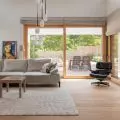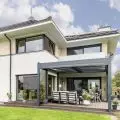World War II Museum in Gdansk
Even the most outstanding architect is not able to convey the tragedy of World War II with a single building. How to pay tribute to even 60 million fallen and express the hope that a similar horror will never happen again in a block? This is an impossible task, so this was not the mission of those designing the building of the World War II Museum in Gdansk.
In the ideological description of the programmatic and technicalconcept prepared for the competition for the building, designers from the Kwadrat architectural studio write that their museum is a "silent project," yet one that screams loudly in people's heads and consciences.
Museum of World War II in Gdansk
photo: Maja Górczak
The designed volume provides a multiplicity of interpretations. Each visitor to this museum may describe it in different words. In the same way, its meaning will differ before and after visiting the permanent exhibition. Representatives of different cultures, countries that were affected by the war in different ways, will have different insights. The architecture very subtly suggests how to read such an emotional place.
Museum of World War II in Gdansk
photo: Maja Górczak
Already from a distance one notices the soaring dominant of the block. This landmark houses the entrance and educational and culturalspaces. The exhibitions are located underground. The architects wanted to visibly distinguish the temporal spaces. The underground represents the past, the ground level and the plaza around the museum represent the present, while the expressive dominant with a vantage point represents the future. The rust-colored façade is reminiscent of dried blood or the color of cattle cars, but also suggests destruction as well as being set in the past. The huge glazing reflects the silhouettes of visitors, who, once inside, avoid eye contact, as if afraid to look the truth in the eye. When the glass part is illuminated it resembles a huge candle, it is like a light of hope pointing towards the sky.
Museum of World War II in Gdansk
photo: Maja Górczak
Locating the entire exhibition below the surface of the ground suggests an encapsulation of evil and a contemporary dissociation from it. The main body abruptly juts out from beneath the ground like those who exercised armed resistance against human enslavement during the war.
World War II Museum in Gdansk
photo: Maja Górczak
Thelump of the World War II Museum is not only an institutional edifice, but also a monument and a manifesto for peace. This place tells about the senselessness of wars in general, the context of World War II is, as it were, a pretext to oppose the satisfaction of the sick ambitions of dictators and the lack of respect for human beings. The permanent exhibition and temporary exhibitions have an anti-war character, but at the same time they promote patriotism and pay tribute to all victims of armed conflicts. The World War II Museum presents the entire history of this tragic event. It does not focus only on the Polish perspective, but also gives voice to other nations.
Emigration Museum in Gdynia
The Emigration Museum in Gdynia stands out from the other facilities described. This is because it is not a museum whose architecture was designed from the ground up specifically with an exhibition function in mind. In addition, this place does not commemorate a specific historical event or figure, but a certain phenomenon and its development over the centuries.
Emigration Museum in Gdynia
photo: Maja Górczak
TheEmigration Museum in Gdynia is located in the building of the old Marine Station, which in the interwar years served as a transit facility for thousands of Poles going abroad. There is an interesting twist of history here - the site of the beginning of the route out of the motherland is located at 1 Polska Street.
The Marine Station was built in a modernist style. The facade of the building on both sides is decorated with two eagles, which were intended to add state and patriotic symbolism to the building. In the old days, the edifice was, depending on the direction of the trip, the first or last building that travelers saw. Today, the eagles are a reminder of the thousands of Poles who left their homeland in search of a better life. The current decorations have been restored in almost identical form as they existed before the wartime destruction.
Key to the body of the Emigration Museum is symmetry. This makes the building extremely elegant. Since the northern part of the building was not preserved after the war, the segment behind the facade is a creative recreation inspired by modernist construction. In the contemporary design by ARSA and ae fusion Studio, a combination of aesthetics from more than 70 years ago and modern materials is evident.
Emigration Museum in Gdynia
photo: Maja Górczak
The attention of those walking along the French waterfront is at first attracted by the glass clearance between the main facade and part of the port warehouse. This is the central part of the museum, which houses the ticket office, bookstore and restaurant. The dome on the ceiling in this part is also made of glass so that the main hall is very well lit.
Thenew building of the Marine Station is designed in such a way that one can easily recognize its previous function. The special footbridges for passengers - the so-called paraseles - are alluded to by a glass vantage point overlooking the waterfront and harbor.
Emigration Museum in Gdynia
photo: Maja Górczak
Although not the entire building of the Emigration Museum in Gdynia was designed from the beginning to house a cultural institution, the building is still worth a look. Unfortunately, viewing the new version of the pearl of modernism is only accessible from one side, as there are still ships docking in the harbor and then it is impossible to approach from the side of the French Quay.


















































































